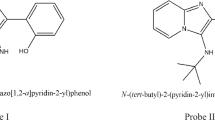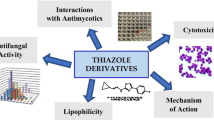Abstract
Candidiasis is a serious public health problem that currently affects not only immunodeficient patients with predisposing conditions, but also immunocompetent individuals. Thus, the search for new antifungal agents is required also due to the emergence of resistant strains and to the side effects of the available drugs. The aim of this study is to evaluate the in vitro antifungal profile of nine synthetic 1,2,3-triazole derivatives against four Candida species of medical importance (C. albicans, C. tropicalis, C. parapsilosis, and C. krusei), as well as to identify their in silico structure-activity relationship. Interestingly, the antifungal susceptibility tests showed the compound 5-methyl-1-(phenylamino)-1H-1,2,3-triazol-4-yl-methanol (2b) with the lowest minimal inhibitory concentration value against C. albicans strain (MIC = 8 μg/mL) similar to other promissing compounds described in the literature. According to our in silico evaluation, some stereoelectronic properties (e.g., higher values of log S and lowest unoccupied molecular orbital energy and lower number of atoms, rotatable bonds and Hydrogen bond acceptors) were correlated with the antifungal activity detected. This series reinforced the potential of 1,2,3-triazole as a promising nucleus in the search for new antifungals and may help on designing new drugs for candidiasis.



Similar content being viewed by others
References
Abdel-Wahab BF, Abdel-Latif E, Mohameda HA, Awad GEA (2012) Design and synthesis of new 4-pyrazolin-3-yl-1,2,3-triazoles and 1,2,3-triazol-4-yl-pyrazolin-1-ylthiazoles as potential antimicrobial agents. Eur J Med Chem 52:263–268
Ahsan MJ, Samy JG, Khalilullah H, Nomani MS, Saraswat P, Gaur R, Singh A (2011) Molecular properties prediction and synthesis of novel 1,3,4-oxadiazole analogues as potent antimicrobial andantitubercular agents. Bioorg Med Chem Lett 21:7246–7250
Antony G, Saralaya V, Bhat KG, Shenoy MS, Shivananda PG (2009) Effect of phenotypic switching on expression of virulence factors by Candida albicans causing candidiasis in diabetic patients. Rev Iberoam Micol 26:202–205
Balouiri M, Sadiki M, Saad KI (2016) Methods for in vitro evaluating antimicrobial activity: A review. J Pharm Anal 6:71–79
Chai X, Zhang J, Cao Y, Zou Y, Wu Q, Zhang D, Jiang Y, Sun Q (2011) Design, synthesis and molecular docking studies of novel triazole as antifungal agent. Eur J Med Chem 46:3167–3176
Cheng MF, Yang YL, Yao TJ, Lin CY, Liu JS, Tang RB, Yu KW, Fan YH, Hsieh KS, Ho M, Lo HJ (2005) Risk factors for fatal candidemia caused by Candida albicans and non-albicans Candida species. BMC Infect Dis 5:1–5
Clinical and Laboratory Standards Institute (CLSI) (2008) Reference Method for Broth Dilution Antifungal Susceptibility Testing of Yeasts; Approved Standard—Third Edition, document M27-A3 (ISBN 1-56238666-2) 28, 1-25, Pennsylvania, USA. http://clsi.org/
Clinical and Laboratory Standards Institute (CLSI) (2009) Method for Antifungal Disk difusion susceptibility testing of yeast. Aproved guideline—second edition. CLSI document M44-A2 (ISBN 1-56238-703-0) 29:1–25 Pensylvania, USA. http://clsi.org/
Colombo AL, Guimarães T (2003) Epidemiologia das infecções hematogênicas por Candida spp. Rev Soc Bras Med Trop 36:599–607
Colombo AL, Nucci M, Park BJ, Nouér SA, Arthington-Skaggs B, Matta DA, Warnock D, Morgan J (2006) Epidemiology of Candidemia in Brazil: a nationwide sentinel surveillance of Candidemia in eleven medical centers. J Clin Microbiol 44:2816–2823
Cunha AC, Ferreira VF, Jordão AK, de Souza MCBV, Wardell SMSV, Wardell JL, Tan PA, Bettens RPA, Seth SK, Tiekink ERT (2013) Aryl-substituents moderate the nature of hydrogen bonds, N–H⋯N versus N–H⋯O, leading to supramolecular chains in the crystal structures of N-arylamino 1,2,3-triazole esters. Cryst Eng Comm 15:4917–4929
Dalvie DK, Kalgutkar AS, Khojasteh-Bakht SC, Obach RS, O’Donnell JP (2002) Biotransformation reactions of five membered aromatic heterocyclic rings. Chem Res Toxicol 15:269–299
Dan ZG, Zhang J, Yu SC, Hu HG, Chai XY, Sun QY, Wu QY (2009) Design and synthesis of noveltriazole antifungal derivatives based on the active site of fungal lanosterol 14α-demethylase (CYP51). Chines Chem Lett 20:935–938
Eggimann P, Garbino J, Pittet D (2003) Management of Candida species infections in critically ill patients. Lancet Infect Dis 3:772–785
Emami S, Shojapour S, Faramarzi MA, Samadi N, Irannejad H (2013) Synthesis, in vitro antifungal activity and in silico study of 3-(1,2,4-triazol-1-yl)flavanones. Eur J Med Chem 66:480–488
Fraser VJ, Jones M, Dunkel J, Storfer S, Medoff G, Dunagan WC (1992) Candidemia in a tertiary care hospital: epidemiology, risk factors, and predictors of mortality. Clin Infect Dis 15:414–421
Horne WS, Yadav MK, Stout CD, Ghadiri MR (2004) Heterocyclic peptide backbone modifications in an alpha-helical coiled coil. J Am Chem Soc 126:15366–15367
Irfan M, Aneja B, Yadava U, Khan SI, Manzoor N, Daniliuc CG, Abid M (2015) Synthesis, QSAR and anticandidal evaluation of 1,2,3-triazoles derived from naturally bioactive scaffolds. Eur J Med Chem 93:246–254
Jordao AK, Afonso PP, Ferreira VF, de Souza MCBV, Almeida MCB, Beltrame CO, Paiva DP, Wardell SMSV, Wardell JL, Tiekink ERT, Damaso CR, Cunha AC (2009) Antiviral evaluation of N-amino-1,2,3-triazoles against Cantagalo virus replication in cell culture. Eur J Med Chem 44:3777–3783
Jordão AK, Ferreira VF, Lima ES, de Souza MCBV, Carlos ECL, Castro HC, Geraldo RB, Almeida MCB, Cunha AC (2009) Synthesis, antiplatelet and silico evaluation of novel N-substituted phenylamino-5-methyl-1H-1,2,3-triazole-carbohydrazides. Bioorg Med Chem 17:3713–3719
Jordão AK, Ferreira VF, Souza TML, Faria GGS, Machado V, Abrantes JL, de Souza MCBV, Cunha AC (2011a) Synthesis and anti-HSV-1 activity of new 1,2,3-triazole derivatives. Bioorg Med Chem 19:1860–1865
Jordão JA, Sathler PC, Ferreira VF, Campos VR, de Souza MCBV, Castro HC, Lannes A, Lourenco A, Rodrigues CR, Bello ML, Lourenco MCS, Carvalho GSL, Almeida MCB, Cunha AC (2011b) Synthesis, antitubercular activity, and SAR study of N-substituted-phenylamino-5-methyl-1H-1,2,3-triazole-4-carbohydrazides. Bioorg Med Chem 19:5605–5611
Jordão AK, Ferreira VF, Cunha AC, Wardell JL, Wardell SMSV, Tiekink ERT (2012) The differing influence of halides upon supramolecular aggregation through C–X⋯π interactions in the crystal structures of (5-methyl-1-(4-X-arylamino)-1H-1,2,3-triazol-4-yl)methanol derivatives, X = H, F and Cl. Cryst Eng Comm 14:6534–6539
Kategaonkar AH, Shinde PV, Kategaonkar AH, Pasale SK, Shingate BB, Shingare MS (2010) Synthesis and biological evaluation of new 2-chloro-3-((4-phenyl-1H-1,2,3-triazol-1-yl)methyl) quinoline derivatives via click chemistry approach. Eur J Med Chem 45:3142–3146
Kaushik CP, Kumar K, Singh SK, Singh D, Saini S (2013) Synthesis and antimicrobial evaluation of 1,4-disubstituted 1,2,3-triazoles with aromatic ester functionality. Arab J Chem Article in press. doi:10.1016/j.arabjc.2013.09.023
Krcmery V, Barnes AJ (2002) Non-albicans Candida spp. causing fungaemia: pathogenicity and antifungal resistance. J Hosp Infect 50:243–260
Lannes AC, Leal B, Novais JS, Lione V, Monteiro GC, Lourenço AL, Sathler PC, Jordão AK, Rodrigues CR, Cabral LM, Cunha AC, Campos V, Ferreira VF, de Souza MC, Santos DO, Castro HC (2014) Exploring N-acylhydrazone derivatives against clinical resistant bacterial strains. Curr Microbiol 69:357–364
Lanternier F, Cypowyj S, Picard C, Bustamante J, Lortholary O, Casanova JL, Puel A (2013) Primary immunodeficiencies underlying fungal infections. Curr Opin Pediatr 25:736–47
Mancuso AJ, Swern D (1981) Activated dimethyl sulfoxide: useful reagents for Synthesis. Synthesis 3:165–184
Melo JOF, Donnici CL, Augusti R, Ferreira VF, De Souza MCBV, Ferreira MLG, Cunha AC (2006) Heterociclos 1,2,3-triazólicos: histórico, métodos de preparação, aplicações e atividades farmacológicas. Quim Nova 29:569–579
Moraca F, De Vita D, Pandolfi F, Di Santo R, Costi R, Cirilli R, D’Auria FD, Panella S, Palamara AT, Simonetti G, Botta M, Scipione L (2014) Synthesis, biological evaluation and structure–activity correlation study of a series of imidazol-based compounds as Candida albicans inhibitors. Eur J Med Chem 83:665–673
Pałkowski Ł, Błaszczyński J, Skrzypczak A, Błaszczak J, Nowaczyk A, Wróblewska J, Kożuszko S, Gospodarek E, Słowiński R, Krysiński J (2015) Prediction of antifungal activity of gemini imidazolium compounds. Biomed Res Int 2015:1–10
Pappas PG (2006) Invasive candidiasis. Infect Dis Clin North Am 20:485–506
Patel PD, Patel MR, Kocsis B, Kocsis E, Graham SM, Warren AR, Nicholson SM, Billack B, Fronczek FR, Talele TT (2010) Design, synthesis and determination of antifungal activity of 5(6)-substituted benzotriazoles. Eur J Med Chem 45:2214–2222
Paulai FR, Serrano SHP, Tavares LC (2009) Aspectos mecanísticos da bioatividade e toxicidade de nitrocompostos. Quim Nova 32:1013–1020
Paramythiotou E, Frantzeskaki F, Flevari A, Armaganidis A, Dimopoulos G (2014) Invasive Fungal Infections in the ICU: How to Approach, How to Treat. Molecules 19:1085–1119
Pfaller MA, Diekema DJ (2007) Epidemiology of invasive candidiasis: a persistent public health problem. Clin Microbiol Rev 20:133–163
Rezaei Z, Khabnadideh S, Pakshir K, Hossaini Z, Amiri F, Assadpour E (2009) Design, synthesis, and antifungal activity of triazole and benzotriazole derivatives. Eur J Med Chem 44:3064–3067
Rodríguez-Pichardo A, García-Bravo B (2006) Candidiasis cutaneomucosas. Manifestaciones clínicas. Medicina Clínica 126:20–24
Sangshetti JN, Lokwani DK, Sarkate AP, Shinde DB (2011) Synthesis, Antifungal Activity, and Docking Study of Some New 1,2,4-triazole Analogs. Chem Biol Drug Des 78:800–809
Spampinato C, Leonardi D (2013) Candida infections, causes, targets, and resistance mechanisms: traditional and alternative antifungal agents. Biomed Res Int 2013:1–13
Terra L, Castro HC, Abreu PA (2014) Molecular modeling of a series of pyridinecarboxamidrazone-azole derivatives with antifungal activity. Med Chem Res 23:5135–5140
Wang XL, Wan K, Zhou CH (2010) Synthesis of novel sulfanilamide-derived 1,2,3-triazoles and their evaluation for antibacterial and antifungal activities. Eur J Med Chem 45:4631–4639
Wisplinghoff H, Bischoff T, Tallent SM, Seifert H, Wenzel RP, Edmond MB (2004) Nosocomial bloodstream infections in US hospitals: analysis of 24,179 cases from a prospective nationwide surveillance study. Clin Infect Dis 39:309–317
Yapar N (2014) Epidemiology and risk factors for invasive candidiasis. Ther Clin Risk Manag 10:95–105
Yu S, Chai X, Hu H, Yan Y, Guan Z, Zou Y, Sun Q, Wu Q (2010) Synthesis and antifungal evaluation of novel triazole derivatives as inhibitors of cytochrome P450 14α-demethylase. Eur J Med Chem 45:4435–4445
Yu S, Wang N, Chai X, Wang B, Cui H, Zhao Q, Zou Y, Sun Q, Meng Q, Wu Q (2013) Synthesis and Antifungal Activity of the novel triazole derivates containing 1,2,3-triazole fragment. Arch Pharm Res 36:1215–1222
Zhu J, Lu J, Zhou Y, Li Y, Cheng J, Zheng C (2006) Design, synthesis, and antifungal activities in vitro of novel tetrahydroisoquinoline compounds based on the structure of lanosterol 14a-demethylase (CYP51) of fungi. Bioorg Med Chem Lett 16:5285–5289
Zou Y, Zhao Q, Liao J, Hu H, Yu S, Chai X, Xu M, Wu Q (2012) New triazole derivatives as antifungal agents: Synthesis via click reaction, in vitro evaluation and molecular docking studies. Bioorg Med Chem Lett 22:2959–2962
Zhou CH, Wang Y (2012) Recent researches in triazole compounds as medicinal drugs. Curr Med Chem 19:239–280
Acknowledgements
This work was supported by Research Support Foundation of the State of Rio de Janeiro (FAPERJ) and Postgraduate Scholarship from Educational Foundation of Macaé (FUNEMAC).
Author information
Authors and Affiliations
Corresponding author
Ethics declarations
Conflict of interest
The authors declare that they have no competing interest.
Electronic supplementary material
Rights and permissions
About this article
Cite this article
Santos, T.F., de Jesus, J.B., Neufeld, P.M. et al. Exploring 1,2,3-triazole derivatives by using in vitro and in silico assays to target new antifungal agents and treat Candidiasis. Med Chem Res 26, 680–689 (2017). https://doi.org/10.1007/s00044-017-1789-x
Received:
Accepted:
Published:
Issue Date:
DOI: https://doi.org/10.1007/s00044-017-1789-x




